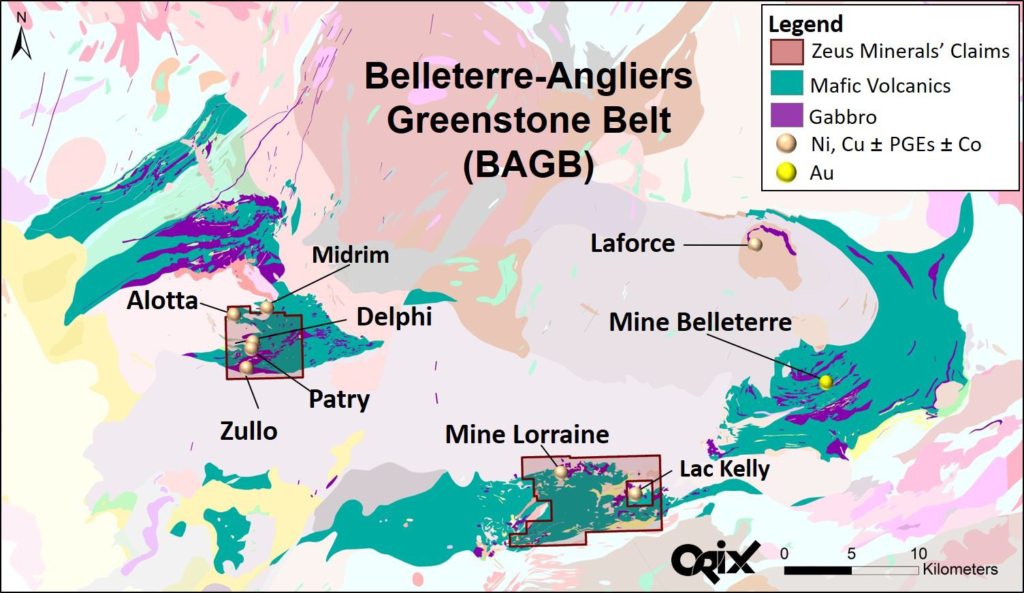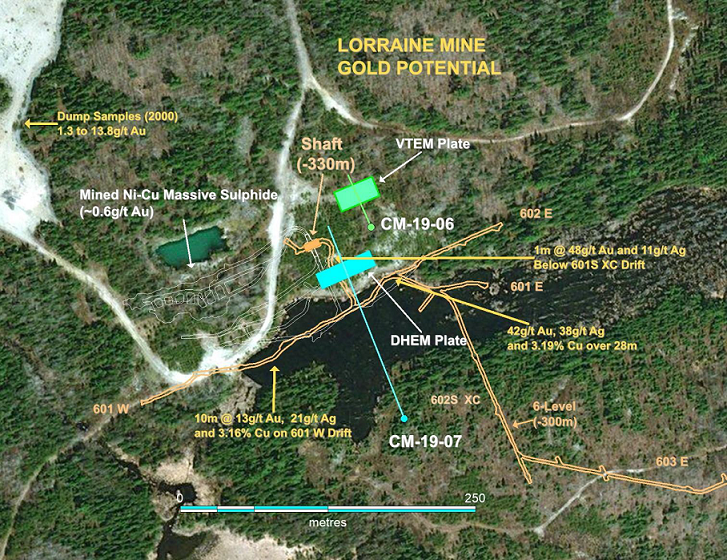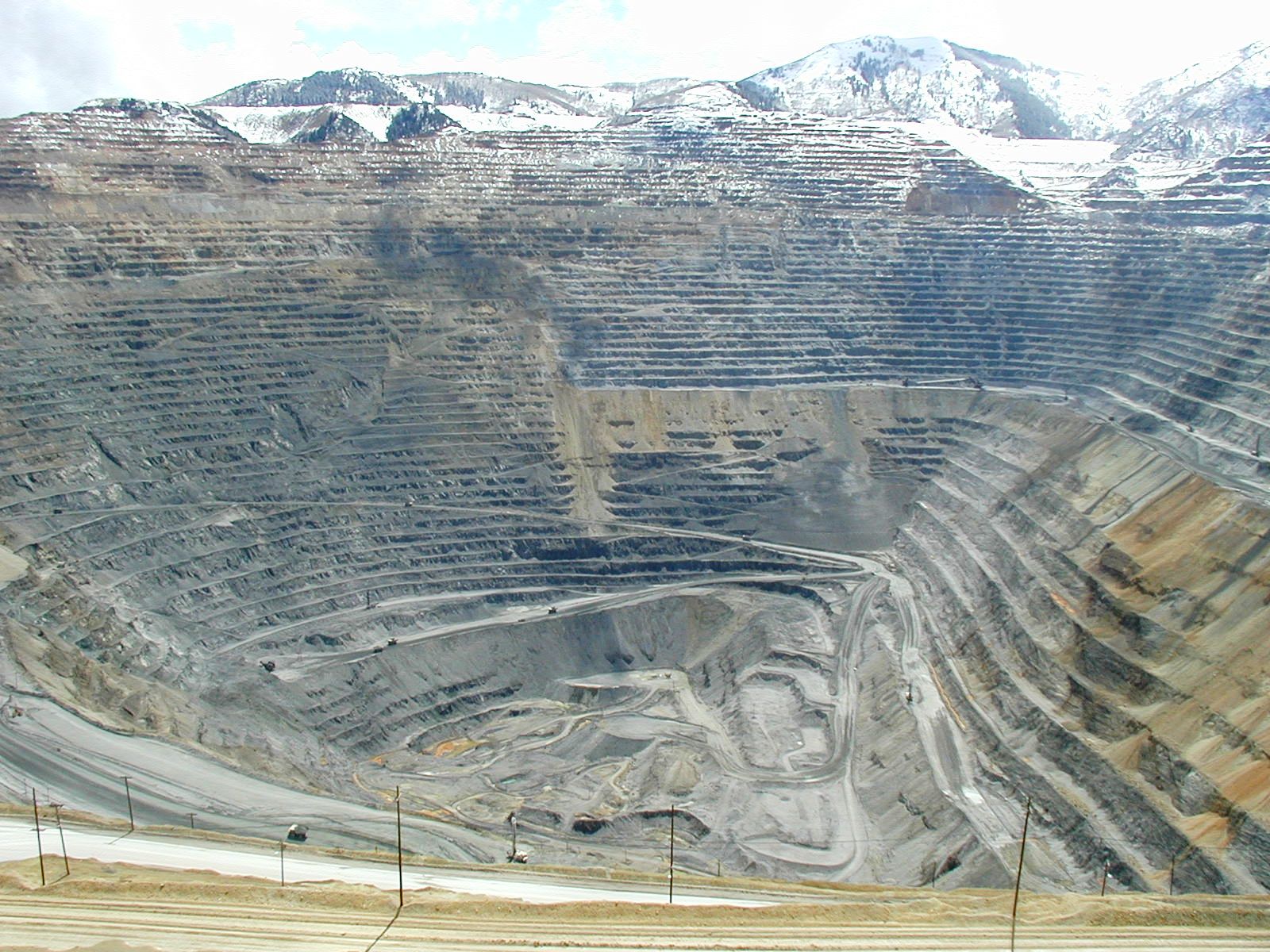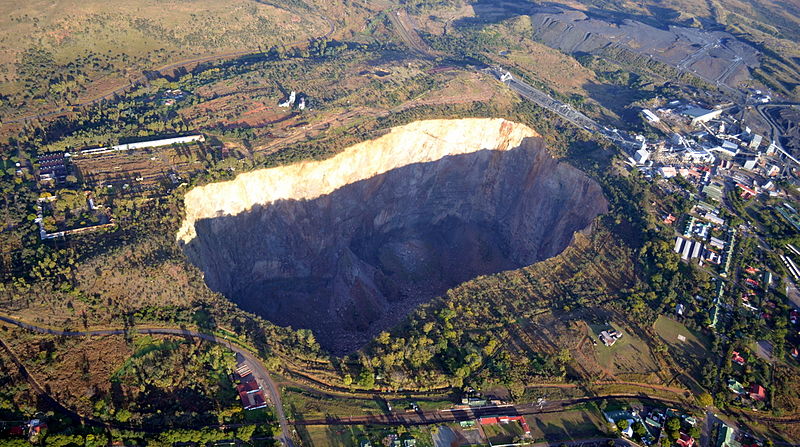The Lorraine Mine in southwestern Quebec, Canada produced more than 600,000 tons of ore grading 1.37% Cu, 0.62% Ni, 0.2 oz. Ag/ton, 0.02 oz Au/ton and unspecified amounts of Platinum Group Elements (PGE) during the 1960s. It was named after the Temagami-Lorrain Mining Company, which carried out exploration on the property in the 1900s, though major Ni-Cu mineralization on the property wasn’t reported until 1953. The area has been worked by a number of companies since the mine closure in 1968 with Hinterland Exploration Ltd (2004-2005) and Chase Mining Ltd (2019 to present) being the most recent.
Lorraine is part of the Belleterre-Angliers Greenstone Belt (BAGB) – the youngest greenstone belt in the Archean Superior Province, Canadian Shield. A number of Cu-Ni-PGE showings and deposits associated with gabbroic bodies typically occupying the area of <500m2 have been documented in the belt: These occurrences include Lac Croche, Midrim, Alotta, Delphi, Patry, the Lorraine mine, Lac Kelly, and La Force. In all cases except the Lorraine Mine, the sulfides occur disseminated, relatively enriched in Cu, and consisting mostly of chalcopyrite (CuFeS2) with lesser pyrrhotite ((Fe,Ni)7S8) and sphalerite (ZnS) within the gabbros proximal to the margins. Only at the Lorraine mine, did the sulfides occur as massive lens enriched in Ni-Cu (contained mostly in pyrrhotite and pentlandite ((FexNiy)Σ9S8)) at the contact between the gabbro and the tholeiitic basalts, overlying the base komatiitic unit.
Over the years, two exploration targets have been the focus of work at Lorraine: a magmatic Ni-Cu deposit like the old Lorraine mine site and PGE deposits discovered at the nearby Blondeau showing. The article focuses on unraveling the ore-forming conditions and ore genesis at the Lorraine Mine.
Geological overview
Geographically, the Lorraine mine is located in Gaboury and Blondeau Townships approximately 30 miles east of Ville-Marie, Quebec. The project consists of 139 mining claims covering >70km2. Geologically, the property belongs to the north-central part of the Lac des Bois Group segment of the BAGB in the Pontiac Subprovince within the Archean Superior Craton. Greenstone belts typically consist of lower volcanic sequences of ultramafic-mafic composition (komatiites, peridotites, basalts; low SiO2-high MgO) and upper sedimentary units (shales, sandstones, conglomerates) and are known to host the some of the world’s most valuable deposits of Ni-sulfides, Cr-V-Ti, PGE and Ag-Au (Barberton, Africa; Kambalda, Australia). They are named so due to the presence of green metamorphic minerals like chlorite, actinolite, and epidote.

The southeastern part of the Lorraine property is underlain by mafic metavolcanic rocks related intrusive sills of dioritic to gabbroic composition. These intrusions are thought to have formed from a mantle plume, which rifted the Belleterre-Angliers island arc. They are younger, form irregular isolated bodies and intrude the tholeiitic basalts of all three groups comprising the belt. Similarly to the latter, they have also experienced secondary alteration of the same facies. The other, northern and central parts of the property are dominated by the large granodiorite batholith, considered as granitic rocks of the Fugereville Pluton. A large Ni-Cu ore body is restricted to the contact between the gabbroic to dioritic intrusion and metavolcanic rocks at the northeast of the property.

Mineralization
The Lorraine deposit is unique among other Ni-Cu deposits found elsewhere in the BAGB: it is a massive sulfide lens up to 40 feet thick which contain high Cu and extremely fractionated PGE. The latter has initiated a long-lasting heated debate around the topic of its origins. Geologists argue whether it is associated with magmatic fractionation or hydrothermal remobilization.
Magmatic model
Typically, magmatic Ni-Cu-PGE deposits are linked with ultramafic-mafic mantle derived rocks like komatiites of Kambalda (Australia) or gabbroids of Noril’sk-Talnakh associated with Siberian flood basalt province (Russia). In the model of their genesis, the ore-forming process depends much more on the interaction of mantle-derived magma with Sulfur-rich wall-rocks and the pressure drop during its ascend than on ore metal contents itself. Truly, to form economic deposit, a magma must contain ore metals but more importantly it should be capable of being saturated with S2-. A process of immiscible sulphide liquid segregation in mafic systems during the differentiation is well-studied, but typically this results in only limited amounts of ore and occurs at late stages of magma crystallization. On the other hand, if the composition, viscosity, temperature and volatile content of magma is susceptible to contaminate enough S-rich crustal rocks during the ascend, it becomes saturated in S and forms large amounts of molten immiscible sulfide liquid which acts as a “collector” for Ni-Cu-Co-PGE and is likely to be settled near the base of intrusion.
Hydrothermal remobilization model
According to the hydrothermal model, the ore metals of the host gabbroic intrusion were incorporated into the hydrothermal fluids during the deformation or alteration which caused remobilization of the existing sulfide minerals. The dissolution and the following precipitation of remobilized sulfide assemblages from hydrothermal solutions is largely controlled by pH level, chemical reduction, dilution and cooling according to modern thermodynamic calculations. In this case, the sulfide minerals are likely to move through fault systems or along fractures. Post-magmatic remobilization may upgrade the existing resources by absorbing the redistributed ore metals from the disseminated sulfides.
What does this mean for exploration?
To test a magmatic theory of ore genesis, the exploration efforts would focus on targets where the sulfides were originated. To test a hydrothermal model, exploration would target sites where sulfides may have been transported during the remobilization. In 2019, Chase undertook a geophysical programme consisting of airborne VTEM and Downhole EM to look for large buried conductors (like massive sulfide lenses), but the drilled anomalies in the vicinity of Lorraine ended up being barren banded iron formations. The Company had more success at the nearby Alotta Prospect where they intersected a massive sulfide body grading 2.17% Ni, 2.15% Cu, 2.94g/t PGE and 0.11% Co. At the Lorraine Mine, Chase has now decided to target higher grade gold showings indicated in the mine records as well as disseminated Ni-Cu mineralization more similar to prospects elsewhere in the area.
Conclusions
We’ve talked before about explorers using the “good neighborhood” method to find prospects and projects to focus on. Areas with previous mines and records of exploration can definitely be considered good neighborhoods, if not completely original. For Lorraine, as for any previously worked project, the challenge is to find what others have missed. Chase hasn’t found new massive sulfide bodies at the Lorraine mine site, but the Alotta results show that there is more potential for massive sulfides lenses in the project area. With new data to digest from the Lorraine mine, they’ve adjusted their thinking and will pursue other targets. That’s what exploration is all about.
Further reading
- Mineralogy of the sulphide minerals (article)
- An overview of the types of sulphide deposits (article)
- An overview of Volcanogenic Massive Sulphide deposits (article)
- Current exploration efforts on the area (Chase Mining)






